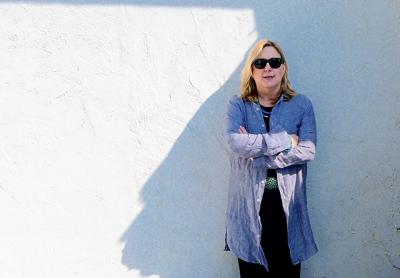Deborah Buck: Like Nature on Steroids

When a retrospective of Deborah Buck’s paintings was held in 2012 at the Garrison Art Center in Garrison, N.Y., several people told her that they resembled her work from 20 years before.
While there is definitely a consistency over the years, it’s like quicksilver — difficult to pin down. Because strange, almost surreal forms are central to her paintings, they aren’t resolutely abstract. At the same time, with a few exceptions, they are not figurative either — except perhaps in her head, where magic is the norm.
“I make images of things I wish existed. Like nature on steroids. It’s like making a world where I can live, a world a little more interesting to me than one without them.”
Her titles are important, she said. “They are clues to what it is I’m trying to convey. As these paintings go through manifestations, there are many layers to them, a lot of push and pull in the process. But when I finally get the title to the image, then it quickly resolves itself.”
“Sonar,” for example, has a variety of elements — a mass that resembles a cluster of mussels or clams, a multicolored disc, an upside-down bottle shape from which little circles descend. “When the title came to me, I figured out that I was under water. The shapes then resonated as sound waves.”
Her most recent paintings begin with an acrylic wash in a single color. Once that dries, depending on its shape, she draws over it with sumi ink. “The shape is like a map to the drawing that’s going to go over it. The ink, with its heavier viscosity, gives my hand more control. It allows me to work very, very fast.”
Ms. Buck was born and raised in and around Baltimore. “I came out of the egg interested in art,” she said. Her mother was a docent at the Baltimore Museum of Art and later studied at Christie’s and Sotheby’s. Both parents encouraged her to think of herself as an artist, but it was her father who put her securely on the road to a life in art. When Ms. Buck was still in high school, Clyfford Still lived in a town near her family’s farm in Maryland. Ms. Buck’s father approached him one day and said, “I’m David Jones, and you’re responsible for my wife dragging me to the Albright-Knox” for a retrospective of his paintings. “But I’m really glad she did.”
Still, who early on broke with the art world’s gallery system, was notoriously private, but both men were farm-team baseball catchers and baseball fans, and they regularly had breakfast at the same restaurant. One day Mr. Jones told the famous painter that his daughter was an artist too, and asked if she could help out in his studio. “He said very nice things the first time he saw my work, and I wrote him a letter thanking him for taking the time. Somehow I struck a chord in him and I saw him on a regular basis.” He became her mentor when she was 16 years old.
In 1975, Still received the Skowhegan School’s Medal for Painting, which entitled him to give a scholarship in his name to a young artist. He chose Ms. Buck. She knew him for the last six years of his life; he died in 1980. “To me, he was like a wizard with this power, the power of the imagery, the paint, the canvas.” She recently learned that he preserved all her letters to him; they are in the archive at the Clyfford Still Museum in Denver.
Ms. Buck attended Trinity College in Hartford. The head of the art department, George Chaplin, who had studied at Yale with Josef Albers, would “come to my basement studio and we would talk about his work and everybody else’s work, and I think that was a formidable education.”
She found a job in Baltimore after graduation with a subsidiary of Disney that animated theme displays for stores and malls. “We engineered them, and we installed them, and I illustrated and designed them. It was really great discipline. It doesn’t matter what you’re drawing if you’re drawing every day.”
After 10 years she had enough money to move, and went to live in Boston. It was a mistake. “Boston was too severe for me, and I realized I had overshot the runway. I was supposed to be in New York.” She has been there ever since.
In 2001, feeling isolated in her studio, she opened Buck House, a gallery on Madison Avenue that carried midcentury modern furniture, contemporary art, photography, and whatever else caught the owner’s eye. “I would occasionally slip one of my paintings in.”
She painted during the years she owned Buck House, but did not try to show her work. “When I closed the gallery five years ago, it was time to begin exhibiting again. I’ve been really lucky. That’s what I’m doing.” Her most recent show was at Ille Arts in Amagansett with John Monti, a sculptor.
The artist was ready for a change. Her son, Sam, was in college, and she was divorced. She rented a little house in Water Mill, and then began to look for one to buy. She found it in Sagaponack, close to Sagg Main Beach.
“There were a bunch of silly little houses there built in the 1980s. I call mine a rescue house, since it was pretty beaten up and nobody wanted it. It was a joke house. But it had good bones and a view of the ocean.”
She now splits her time between Sagaponack and the city, with studios in both places.
